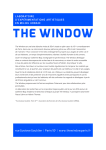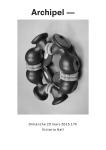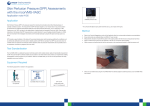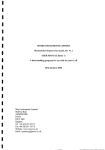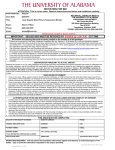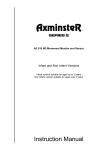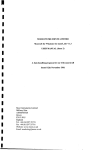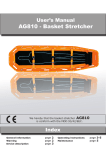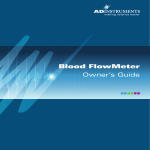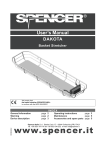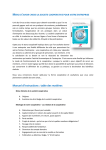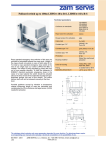Download Tooth vitality testing using moorVMS-LDF
Transcript
innovation in microvascular assessment Tooth vitality testing using moorVMS-LDF Method Application note #100 • Ensure your moorVMS-LDF module is calibrated and with an in-date service record. • Ensure your probes are clean; disinfect with Cidex OPA where facilities and local regulations allow. If sterilisation is required use the Sterrad low temperature technique (see Q36 Cleaning and handling of optic probes, supplied with all Application optic probes). • Set the LD time constant of the system to 0.1 seconds (to view pulsatility). Laser Doppler (LD) is considered more reliable than sensory testing for vitality assessment (4). This is because there can • Consider using warm mouth wash to enhance local flow, then insert the dental splint into the patients mouth. be adequate vascularisation to support tooth pulp vitality even when sensation is lost due to nerve damage. Blood flow is • Ensure the probe tip is in contact with the tooth is held firmly in the dental splint (see practical suggestions). assessed by placing laser Doppler probes in contact with the teeth, typically using a dental putty splint to support the probe. • Ensure optic fibres are supported and not swinging free (possibly tape the probe leads to fixed surfaces). The graph below illustrates a simultaneous comparison of blood flow in Vital and Non Vital teeth. Further confirmation can be • Sample continuously for at least a minute to obtain a trace free of movement artefact signals. obtained by using FFT analysis of the blood flow recording to investigate the presence or absence of the cardiac pulse. • Vitality is assessed by the magnitude of the LD signal, presence of cardiac pulsatility and other, natural, spontaneous variations in blood flow. • Trace Characteristics: Please refer to publications for further hints / tips. Analysis Vital: Relatively high blood flow usually with a pulsatile (cardiac Tooth Vitality is confirmed by frequency) component. examining both the pulsatility and magnitude of the traces. Non Vital: Relatively low blood flow Trace Characteristics: with no clear pulsatility. Vital: Relatively high blood flow Equipment Required usually with a pulsatile (cardiac frequency) component. The following equipment is required for tooth Pulp Vitality testing: - Non Vital: Relatively low blood flow with no clear pulsatility. moorVMS-LDF laser moorVMS-PC Windows 15-20mm VP3 blunt needle, end Doppler module software and PC delivery laser Doppler probe for As a further aid to vitality assessment, assessment of front teeth it is possible to quantify and assess cardiac pulsatility of the tooth blood flow: the flux traces can be transformed with Fourier analysis (FFT using moorVMS-PC software). FFT examples are shown left; note the prominence of the peak at cardiac frequency (here about 60 cycles per VP5 blunt needle, 90 degree end Bur drill (size 2 round bur and Quick Setting Dental delivery laser Doppler probe for countersunk with a size 6) impression putty to make assessment of rear teeth minute) indicating pulp vitality. dental splint for optic probes 1 2 innovation in microvascular assessment Tooth vitality testing using moorVMS-LDF Method Application note #100 • Ensure your moorVMS-LDF module is calibrated and with an in-date service record. • Ensure your probes are clean; disinfect with Cidex OPA where facilities and local regulations allow. If sterilisation is required use the Sterrad low temperature technique (see Q36 Cleaning and handling of optic probes, supplied with all Application optic probes). • Set the LD time constant of the system to 0.1 seconds (to view pulsatility). Laser Doppler (LD) is considered more reliable than sensory testing for vitality assessment (4). This is because there can • Consider using warm mouth wash to enhance local flow, then insert the dental splint into the patients mouth. be adequate vascularisation to support tooth pulp vitality even when sensation is lost due to nerve damage. Blood flow is • Ensure the probe tip is in contact with the tooth is held firmly in the dental splint (see practical suggestions). assessed by placing laser Doppler probes in contact with the teeth, typically using a dental putty splint to support the probe. • Ensure optic fibres are supported and not swinging free (possibly tape the probe leads to fixed surfaces). The graph below illustrates a simultaneous comparison of blood flow in Vital and Non Vital teeth. Further confirmation can be • Sample continuously for at least a minute to obtain a trace free of movement artefact signals. obtained by using FFT analysis of the blood flow recording to investigate the presence or absence of the cardiac pulse. • Vitality is assessed by the magnitude of the LD signal, presence of cardiac pulsatility and other, natural, spontaneous variations in blood flow. • Trace Characteristics: Please refer to publications for further hints / tips. Analysis Vital: Relatively high blood flow usually with a pulsatile (cardiac Tooth Vitality is confirmed by frequency) component. examining both the pulsatility and magnitude of the traces. Non Vital: Relatively low blood flow Trace Characteristics: with no clear pulsatility. Vital: Relatively high blood flow Equipment Required usually with a pulsatile (cardiac frequency) component. The following equipment is required for tooth Pulp Vitality testing: - Non Vital: Relatively low blood flow with no clear pulsatility. moorVMS-LDF laser moorVMS-PC Windows 15-20mm VP3 blunt needle, end Doppler module software and PC delivery laser Doppler probe for As a further aid to vitality assessment, assessment of front teeth it is possible to quantify and assess cardiac pulsatility of the tooth blood flow: the flux traces can be transformed with Fourier analysis (FFT using moorVMS-PC software). FFT examples are shown left; note the prominence of the peak at cardiac frequency (here about 60 cycles per VP5 blunt needle, 90 degree end Bur drill (size 2 round bur and Quick Setting Dental delivery laser Doppler probe for countersunk with a size 6) impression putty to make assessment of rear teeth minute) indicating pulp vitality. dental splint for optic probes 1 2 Practical Suggestions Confounding Factors Supporting the probe: Dental Putty Splint. There are several factors that can prevent a clear descrimination between vital and non vital teeth. Assuming your machine is Measurements free of movement artefact signals can be obtained when the laser Doppler optic fibre probe is supported in a in service and is calibrated, the following additional notes may be useful. dental putty splint (although successful hand held measurements have been reported). The splint also ensures reproducible Instrument Noise - laser Doppler monitors are calibrated using a two point calibration. The two points used are 1. the positioning at follow-up to assess progress. factory set ‘instrument zero’ value and 2. the flow value following calibration. It is possible to check instrument zero by Dental splints are made for the individual patient using dental impression putty (e.g. President Putty). Mould the putty to the placing the probe in a static reflector. In this case a value of less than 2 perfusion units should be seen (but not 0). This is patients’ teeth, then drill a small hole (size 2) at 2 to 3mm from the gingival margin (first test positions using a needle). deliberate so that the user has confidence that the correct amount of instrument noise has been subtracted at factory set up. If 0 perfusion units is seen it is not possible to determine if too much noise has been subtracted. If you do measure 0 perfusion units then please contact [email protected] for advice. Scattered light from gingiva - light scattered into the gingiva, where faster moving blood is present, can influence the assessment by ‘adding’ to the low flow seen in the tooth. This is more likely if the probe is placed near the gingiva. This can be prevented by making a shield from thin, black rubber sheeting, to surround the tooth prior to fitting the dental splint. Refer to the Matthews paper listed in the publications for further information. Dental putty probe holder for chronic blood flow measures. Bandwidth - the moorVMS-LDF defaults to 14.9Khz upper bandwidth. This will enable pulsatility to be seen more clearly. A Dental putty probe holder in position with 2 laser Doppler probes. restricted bandwidth of 3Khz will offer superior signal to noise in very low flow conditions, but is less suited for FFT analysis. Publications Notes 1. Chen, E., & Abbott, P. V. (2011). Evaluation of accuracy, reliability, and repeatability of five dental pulp tests. Journal of endodontics 2. Mesaros, S., Trope, M., Maixner, W., & Burkes, E. J. (1997). Comparison of two laser Doppler systems on the measurement of blood flow of premolar teeth under different pulpal conditions. International endodontic journal 3. Roeykens, H., & De Moor, R. (2011). The use of laser Doppler flowmetry in paediatric dentistry. European archives of paediatric dentistry: official journal of the European Academy of Paediatric Dentistry 4. Roeykens, H., Van Maele, G., Martens, L., & De Moor, R. (2002). A two-probe laser Doppler flowmetry assessment as an exclusive diagnostic device in a long-term follow-up of traumatised teeth: a case report. Dental traumatology: official publication of International Association for Dental Traumatology 5. Zerari-Mailly, F., & Braud, A. (2012). Glutamate control of pulpal blood flow in the incisor dental pulp of the rat. European Journal of Oral Science, 402–7. Further Reading moorVMS-LDF User Manual. Q36 cleaning and handling of optic probes. www.moor.co.uk - information about laser Doppler monitors and probes. Clinical advice courtesy of Heather Pitt-Ford, St Thomas’ & Guys Hospital, London. www.primadentalgroup.com - bur drill supplies. Important Disclaimer: This information is provided to further clinical research into diagnostic capabilities of laser Doppler. The moorVMS-LDF is CE marked for human use but not specifically for clinical diagnosis of tooth vitality. Calibrated equipment with a current service record should only be used. innovation in microvascular assessment Moor Instruments Ltd Millwey Axminster Devon EX13 5HU UK tel +44 (0)1297 35715 fax +44 (0)1297 35716 email [email protected] website www.moor.co.uk Issue 2 3 4 Practical Suggestions Confounding Factors Supporting the probe: Dental Putty Splint. There are several factors that can prevent a clear descrimination between vital and non vital teeth. Assuming your machine is Measurements free of movement artefact signals can be obtained when the laser Doppler optic fibre probe is supported in a in service and is calibrated, the following additional notes may be useful. dental putty splint (although successful hand held measurements have been reported). The splint also ensures reproducible Instrument Noise - laser Doppler monitors are calibrated using a two point calibration. The two points used are 1. the positioning at follow-up to assess progress. factory set ‘instrument zero’ value and 2. the flow value following calibration. It is possible to check instrument zero by Dental splints are made for the individual patient using dental impression putty (e.g. President Putty). Mould the putty to the placing the probe in a static reflector. In this case a value of less than 2 perfusion units should be seen (but not 0). This is patients’ teeth, then drill a small hole (size 2) at 2 to 3mm from the gingival margin (first test positions using a needle). deliberate so that the user has confidence that the correct amount of instrument noise has been subtracted at factory set up. If 0 perfusion units is seen it is not possible to determine if too much noise has been subtracted. If you do measure 0 perfusion units then please contact [email protected] for advice. Scattered light from gingiva - light scattered into the gingiva, where faster moving blood is present, can influence the assessment by ‘adding’ to the low flow seen in the tooth. This is more likely if the probe is placed near the gingiva. This can be prevented by making a shield from thin, black rubber sheeting, to surround the tooth prior to fitting the dental splint. Refer to the Matthews paper listed in the publications for further information. Dental putty probe holder for chronic blood flow measures. Bandwidth - the moorVMS-LDF defaults to 14.9Khz upper bandwidth. This will enable pulsatility to be seen more clearly. A Dental putty probe holder in position with 2 laser Doppler probes. restricted bandwidth of 3Khz will offer superior signal to noise in very low flow conditions, but is less suited for FFT analysis. Publications Notes 1. Chen, E., & Abbott, P. V. (2011). Evaluation of accuracy, reliability, and repeatability of five dental pulp tests. Journal of endodontics 2. Mesaros, S., Trope, M., Maixner, W., & Burkes, E. J. (1997). Comparison of two laser Doppler systems on the measurement of blood flow of premolar teeth under different pulpal conditions. International endodontic journal 3. Roeykens, H., & De Moor, R. (2011). The use of laser Doppler flowmetry in paediatric dentistry. European archives of paediatric dentistry: official journal of the European Academy of Paediatric Dentistry 4. Roeykens, H., Van Maele, G., Martens, L., & De Moor, R. (2002). A two-probe laser Doppler flowmetry assessment as an exclusive diagnostic device in a long-term follow-up of traumatised teeth: a case report. Dental traumatology: official publication of International Association for Dental Traumatology 5. Zerari-Mailly, F., & Braud, A. (2012). Glutamate control of pulpal blood flow in the incisor dental pulp of the rat. European Journal of Oral Science, 402–7. Further Reading moorVMS-LDF User Manual. Q36 cleaning and handling of optic probes. www.moor.co.uk - information about laser Doppler monitors and probes. Clinical advice courtesy of Heather Pitt-Ford, St Thomas’ & Guys Hospital, London. www.primadentalgroup.com - bur drill supplies. Important Disclaimer: This information is provided to further clinical research into diagnostic capabilities of laser Doppler. The moorVMS-LDF is CE marked for human use but not specifically for clinical diagnosis of tooth vitality. Calibrated equipment with a current service record should only be used. innovation in microvascular assessment Moor Instruments Ltd Millwey Axminster Devon EX13 5HU UK tel +44 (0)1297 35715 fax +44 (0)1297 35716 email [email protected] website www.moor.co.uk Issue 2 3 4




